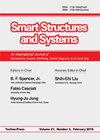A multi-physics informed antenna sensor model through the deep neural network regression
IF 2.2
3区 工程技术
Q2 ENGINEERING, CIVIL
引用次数: 1
Abstract
A passive wireless strain sensing method using antenna sensors has significantly advanced structural health monitoring systems. Since the dimensions of antenna sensors are sensitive to their strain sensing performance and operating frequency, an iterative tuning process is required to achieve a final optimized design. Although multi-physics finite element simulation enables accurate estimation of antenna performance for each turning iteration, the simulation process requires high computational resources. Therefore, antenna tuning processes are recognized as obstacles to delay the final design process. In this study, we explore the potential of multi-physics informed models as an alternative approach for analyzing antenna sensors. Through deep neural networks, as a branch of the machine-learning algorithms, we formulate multi-physics informed models with six input parameters (antenna dimensions) and two outputs (resonance frequency and strain sensitivity). Twenty-two hundred high fidelity data sets are prepared by simulating multi-physics models: 1,600, 400, and 200 data sets are applied to deep neural network regression (DNNR) training, validating, and testing, respectively. From extensive data investigation, an optimized DNNR architecture is obtained to be two layers, with 16 neurons in each layer. Its training, validating, and testing values of mean square errors are 13.01, 44.22, 37.27, respectively. Finally, the proposed multi-physics informed model predicts the resonance frequency and strain sensitivity with errors of 0.1% and 0.07%, respectively. In addition, since the average computation speed for each tuning process is 0.007 seconds, the practical usefulness of the proposed method is also proven.基于深度神经网络回归的多物理场通知天线传感器模型
使用天线传感器的无源无线应变传感方法具有显著先进的结构健康监测系统。由于天线传感器的尺寸对其应变传感性能和工作频率敏感,因此需要迭代调谐过程来实现最终的优化设计。尽管多物理有限元模拟能够准确估计每次转弯迭代的天线性能,但模拟过程需要较高的计算资源。因此,天线调谐过程被认为是延迟最终设计过程的障碍。在这项研究中,我们探索了多物理知情模型作为分析天线传感器的替代方法的潜力。通过深度神经网络,作为机器学习算法的一个分支,我们建立了具有六个输入参数(天线尺寸)和两个输出参数(谐振频率和应变灵敏度)的多物理知情模型。通过模拟多物理模型制备了2200个高保真度数据集:分别将1600、400和200个数据集应用于深度神经网络回归(DNNR)训练、验证和测试。通过大量的数据调查,优化的DNNR结构为两层,每层有16个神经元。其训练、验证和检验均方误差值分别为13.01、44.22和37.27。最后,所提出的多物理知情模型预测了共振频率和应变灵敏度,误差分别为0.1%和0.07%。此外,由于每个调谐过程的平均计算速度为0.007秒,因此也证明了所提出的方法的实用性。
本文章由计算机程序翻译,如有差异,请以英文原文为准。
求助全文
约1分钟内获得全文
求助全文
来源期刊

Smart Structures and Systems
工程技术-工程:机械
CiteScore
6.50
自引率
8.60%
发文量
0
审稿时长
9 months
期刊介绍:
An International Journal of Mechatronics, Sensors, Monitoring, Control, Diagnosis, and Management airns at providing a major publication channel for researchers in the general area of smart structures and systems. Typical subjects considered by the journal include:
Sensors/Actuators(Materials/devices/ informatics/networking)
Structural Health Monitoring and Control
Diagnosis/Prognosis
Life Cycle Engineering(planning/design/ maintenance/renewal)
and related areas.
 求助内容:
求助内容: 应助结果提醒方式:
应助结果提醒方式:


